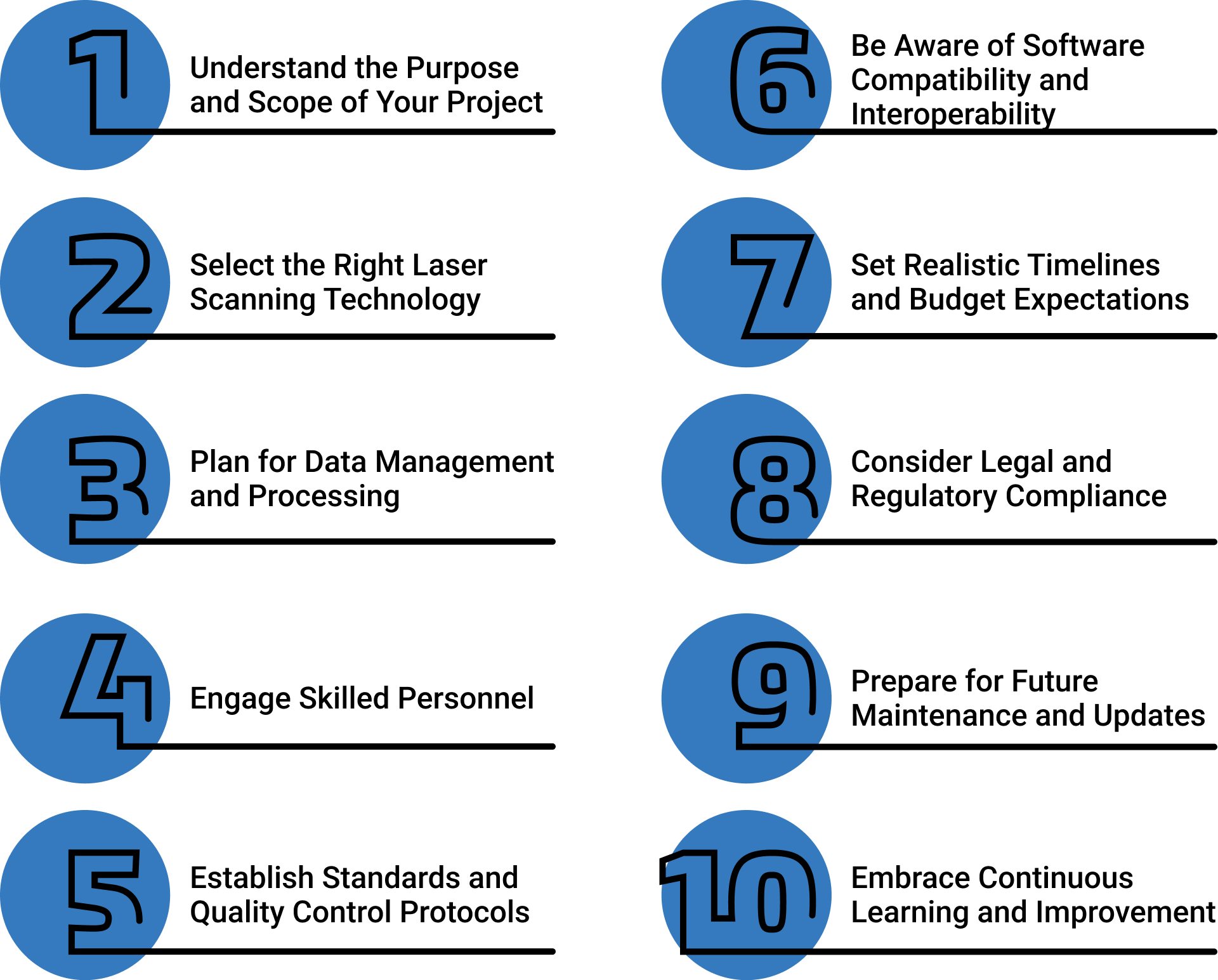Starting a Point Cloud to BIM (Building Information Modeling) project can seem daunting due to its technical nature and the precision required. However, understanding the essential steps and considerations can ensure a smooth and successful process. Point Cloud to BIM services offer unparalleled accuracy in capturing existing structures, making it ideal for projects requiring detailed as-built documentation, renovation, or retrofitting.
Here’s What You Need to Know Before Beginning Your Point Cloud to BIM Journey

1. Understand the Purpose and Scope of Your Project
Before starting a Point Cloud to BIM project, it’s crucial to define the project’s purpose and scope clearly. Ask yourself:
- What is the primary goal of this BIM model? (e.g., renovation, facility management, historic preservation)
- Which specific areas of the structure need to be captured in detail?
- Are there particular MEP (Mechanical, Electrical, and Plumbing) or structural systems that require detailed modelling?
Defining these parameters upfront ensures that your team captures only the necessary data, saving time and resources.
2. Select the Right Laser Scanning Technology
The quality of the point cloud data significantly impacts the final BIM model, so selecting the appropriate laser scanning technology is essential. Considerations include:
- Accuracy Requirements: High-resolution laser scanners provide detailed data but can be more expensive. Choose a scanner that meets the accuracy needs of your project without exceeding them.
- Site Conditions: Indoor or outdoor environments, weather conditions, and accessibility affect the type of scanner used. Portable and durable scanners are ideal for challenging or offsite locations.
- Data Density: For intricate MEP systems or detailed architectural features, denser point cloud data is preferable, as it provides better detail for the BIM model.
3. Plan for Data Management and Processing
Point Cloud to BIM projects generate vast amounts of data, and managing it effectively is critical. Implementing a robust data processing and storage plan from the start can streamline the process:
- Data Storage Solutions: Cloud-based or high-capacity local storage systems can be used to accommodate large datasets produced by laser scanning.
- Data Cleaning and Filtering: Point cloud data often contains noise or unnecessary information. Use software to filter and clean the data to enhance model accuracy.
- Efficient Data Transfer: Ensure that data transfer and sharing protocols are in place, as point cloud files can be large and require efficient methods to move between team members and stakeholders.
4. Engage Skilled Personnel
A successful Point Cloud to BIM project requires skilled professionals understand laser scanning and BIM modelling. Key roles include:
- Surveyors and Laser Scanning Specialists: These professionals ensure accurate data capture, considering site conditions and project requirements.
- BIM Specialists and Modelers: BIM specialists are essential for converting point cloud data into a detailed BIM model that serves your project’s needs.
- Project Managers: A project manager coordinates between surveyors, BIM specialists, and stakeholders to ensure alignment and communication throughout the project.
Consider training your in-house team or partnering with experienced providers specializing in Point Cloud to BIM services.
5. Establish Standards and Quality Control Protocols
Defining quality standards and protocols for Point Cloud to BIM ensures consistency and accuracy. Some practices include:
- The BIM Execution Plan (BEP) outlines the project’s BIM standards, workflows, and quality assurance practices. It serves as a reference to ensure everyone follows the same processes.
- Level of Detail (LOD): Specify the level of detail required for the BIM model based on the project’s purpose. For example, a high LOD is often necessary for MEP components in a renovation project, while a lower LOD might be sufficient for general facility management.
- Regular Quality Checks: Conduct routine quality checks on the point cloud data and BIM model to ensure accuracy and completeness. This helps to identify potential errors early and maintain the model’s integrity.
6. Be Aware of Software Compatibility and Interoperability
Point Cloud to BIM requires software to process and integrate point cloud data into a BIM environment. However, compatibility is critical.
- Interoperable Software: Ensure the laser scanning software is compatible with your BIM platform (such as Revit, ArchiCAD, or Bentley). This compatibility minimizes data conversion issues.
- Integration with Existing Systems: If the BIM model will be used for facility management, verify that it can integrate with the building’s existing systems or databases.
- File Formats and Data Sharing: Understand the preferred file formats for point cloud data, such as RCP, E57, or LAS, to streamline data sharing and collaboration with team members.
7. Set Realistic Timelines and Budget Expectations
Point Cloud to BIM projects often involve additional steps, such as laser scanning, data processing, and model refinement, compared to traditional BIM projects. Therefore, realistic time and budget estimates are essential. Some tips include:
- Project Timeline: Factor in time for data capture, processing, model creation, and quality checks. Setting up a phased timeline helps keep the project on track.
- Budget Considerations: Point Cloud to BIM projects may have higher initial costs due to laser scanning equipment, software, and skilled personnel. However, these upfront costs often lead to long-term savings by reducing errors and rework.
8. Consider Legal and Regulatory Compliance
Before capturing data and creating a BIM model, ensure that your project complies with relevant regulations:
- Data Privacy: For public or private space projects, verify that data collection abides by privacy laws and does not infringe on occupant rights.
- Building Codes and Standards: Ensure your BIM model adheres to local building codes and industry standards, especially if the project involves renovations or structural adjustments.
- Project Documentation: Retain proper documentation of all scanned data and models, as it may be required for regulatory reviews or inspections.
9. Prepare for Future Maintenance and Updates
One of the benefits of Point Cloud to BIM is that it provides an accurate as-built model for ongoing facility management. To maximize this benefit:
- Plan for Model Updates: Develop a protocol for updating the BIM model as modifications are made to the structure. This ensures that the model remains accurate for future use.
- Coordinate with Facility Management Teams: Work closely with facility managers to make the BIM model a valuable resource for ongoing maintenance, upgrades, and asset management.
- Utilize Digital Twins: Consider creating a digital twin from the BIM model for real-time monitoring and optimization, especially in complex structures or facilities with extensive MEP systems.
10. Embrace Continuous Learning and Improvement
Point Cloud to BIM technology is evolving, and staying informed of new advancements is essential for continuous improvement.
- Industry Trends: Follow industry publications and attend relevant conferences or workshops to keep abreast of the latest advancements in laser scanning and BIM technology.
- Software and Technology Updates: Regularly update your software to take advantage of new features, improvements in data processing, and enhanced interoperability.
- Team Training and Development: Invest in ongoing training for your team to stay competitive and maximize the capabilities of Point Cloud to BIM in your projects.
Conclusion
Starting a Point Cloud to BIM project is a complex yet rewarding process that requires careful planning, skilled professionals, and a commitment to quality. By understanding the purpose of your project, selecting the right tools, and following best practices, you can harness the full potential of Point Cloud to BIM. This technology improves accuracy and efficiency and enhances the longevity and functionality of your building assets, making it a worthwhile investment for projects in today’s rapidly advancing construction industry.
With these foundational insights, you are well-prepared to embark on your Point Cloud to BIM project and leverage the precision and benefits it offers to make your project a success.


Recent Comments